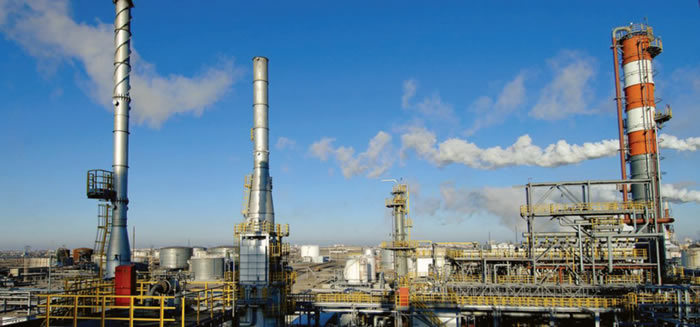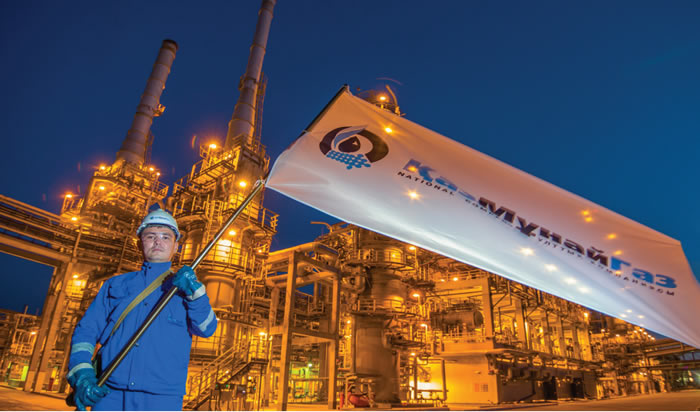Exclusive
2017 Financial and Operational Results of KazMunayGas
JSC National Company KazMunayGas, Kazakhstan's vertically integrated oil and gas company, announced its IFRS financial results and operational highlights for the year ended 31 December 2017.

2017 Financial Highlights:
Revenue up 32% y-o-y to KZT 2,459 bln (USD 7,542 mln[1]).
- Net profit up 44% y-o-y to KZT 520 bln (USD 1,594 mln).
- Capital expenditure up 15% y-o-y to KZT 637 bln (USD 1,954 mln), including cash capital expenditures of KZT 464 bln (USD 1,424 mln).
- Net debt amounted to KZT 1,341 bln (USD 4,036 mln).
2017 Operational Highlights[2]:
- Oil and gas condensate production up 3% y-o-y to 23,362 thousand tonnes (486 kbopd[3]).
- Natural and associated gas production up 8% y-o-y to 7,997 mcm.
- Oil transportation up 3% y-o-y to 65,489 thousand tonnes; Gas transportation up 15% y-o-y, amounting to 100.9 bcm.
- Refining volumes in Kazakhstan up 3% y-o-y to 14,874 thousand tonnes. The net share of NC KMG amounted to 12,173 thousand tonnes, up 3% y-o-y.
- KMGI’s (Petromidia) refining volume up 5% y-o-y to 5,662 thousand tonnes.
Corporate Highlights and Subsequent Events:
- In December 2017, the term for the exercise of NC KMG's option to buy back a 50% stake in PCLL KMG Kashagan B.V. was extended from 2018-2020 until 2020-2022.
- In October 2017, the Caspian Pipeline Consortium (“CPC”) completed all works under the CPC Capacity Expansion Project increasing throughput of Kazakhstan segment to 53.7 mln tonnes per year.
- In October 2017, “KazTransGas” JSC (“KTG”) started exporting gas of Kazakh origin to China under the sale and purchase agreement between KTG and PetroChina for 5 bcm per year gas supplies.
- In 2017, the throughput capacity of the Kazakhstan-China and Beineu-Shymkent gas pipelines were increased to 52 bcm and 10 bcm per year, respectively.
- In September 2017, Kazakhstan and Uzbekistan signed a Framework Agreement for the transportation of up to 5 mln tonnes of oil per year from Russia to Uzbekistan through Kazakhstan and development of appropriate pipeline capacities.
- In April 2017, NC KMG issued a new Eurobond for USD 2.75 bln, which represented the largest corporate transaction in CIS since 2013.
- NC KMG completed modernisation works at Atyrau and Pavlodar refineries in 2017. The first phase of the modernisation of the Shymkent refinery was completed in June 2017; the second phase is to be completed in 2018, aiming at increasing the depth of refining and increasing capacity from 5.2 to 6 mln tonnes.

2017 Financial Results
Revenue in 2017 amounted to KZT 2,459 bln (USD 7,542 mln), up 32% y-o-y. This is a result of a combination of factors: a 23.5% y-o-y increase in the average price of Brent oil and increased oil sales under the Company's long-term oil and LPG supply agreement[4]. Sales as part of this agreement amounted to KZT 1,153 bln (USD 3,537 mln), up by +68% y-o-y in 2017. Sales under this agreement began in 2Q 2016.
Cost of sales increased to KZT 2,380 bln (USD 7,300 mln), up 52% y-o-y. This was largely due to the cost of oil purchased from Tengizchevroil LLP (TCO) for deliveries under the long-term oil and LPG supply agreement and change in the oil purchasing scheme, which altogether amounted to KZT 1,316 bln (USD 4,037 mln) in 2017 vs. KZT 685 bln (USD 2,100 mln) in 2016. Another factor was an increase in the mineral extraction tax by 130% YoY, amounting to KZT 94 bln (USD 287 mln) in 2017 due to the 23.5% increase in the average price of Brent.
NC KMG's operating loss in 2017 amounted to KZT 401 bln (USD 1,230 mln) vs. KZT 25 bln (USD 72 mln) in 2016. The operating profit of NC KMG does not include revenues from the sale of oil and oil products through KMG International (“KMGI”), due to the fact that KMG I is in the process of sale, and therefore accounted as discontinued operations in the consolidated financial statements of NC KMG under IFRS. However, the cost of sales related to the purchase of oil and oil products for KMGI trading purposes is accounted for in the operating profit of NC KMG starting from Q3 2017, due to a change in the purchasing scheme and amounted to KZT 280 bln (USD 858 mln). As a result, NC KMG’s operating profit decreased on y-o-y basis. In turn, the net profit of KMG I is accounted for in the consolidated profit of NC KMG as profit from discontinued operations[5].
NC KMG’s share in the net profit of its associated companies and joint ventures amounted to KZT 415 bln (USD 1,272 mln), a 53% increase y-o-y. The main growth driver was TCO. In 2017, TCO’s profit increased by 96% y-o-y, NC KMG’s share amounted to KZT 290 bln (USD 890 mln).
In 2017, NC KMG recorded a foreign exchange gain of KZT 67 bln (USD 206 mln).
The Company’s net profit[6] increased by 44% y-o-y to KZT 520 bln (USD 1,594 mln) vs KZT 360 bln (USD 1,053 mln) in 2016.
Taxes and other mandatory payments amounted to KZT 1,027 bln (USD 3,150 mln) in 2017.
Capital expenditure amounted to KZT 637 bln (USD 1,954 mln), an increase of 15% y-o-y, including cash capital expenditures of KZT 464 bln (USD 1,424 mln).
The Company's net debt at the end of 2017 amounted to KZT 1,341 bln (USD 4,036 mln).
Cash and cash equivalents, including cash as deposits, amounted to KZT 2,960 bln (USD 8,908 mln), 38% higher than the balance as at YE2016.



